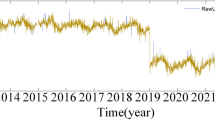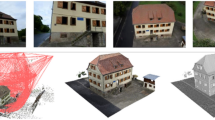Abstract
Modern methods of geostatistics deliver an essential contribution to Environmental Impact Assessment (EIA). These methods allow for spatial interpolation, forecast and risk assessment of expected impact during and after mining projects by integrating different sources of data and information. Geostatistical estimation and simulation algorithms are designed to provide both, a most likely forecast as well as information about the accuracy of the prediction. The representativeness of these measures depends strongly on the quality of the inferred model parameters, which are mainly defined by the parameters of the variogram or the covariance function. Available data may be sparse, trend affected and of different data type making the inference of representative geostatistical model parameters difficult. This contribution introduces a new method for best fitting of the geostatistical model parameters in the presence of a trend, which utilizes the empirical and theoretical differences between Universal Kriging and trend-predictions. The method extends well known approaches of cross validation in two aspects. Firstly, the model evaluation is not only limited to sample data locations but is performed on any prediction locations of the attribute in the domain. Secondly, it extends the measure used in cross validation, based on a single point replacement by using error curves. These allow defining rings of influence representing errors resulting from separate variogram lags. By analyzing the different variogram lags the fit of the complete covariance can be assessed and the influence of the several model parameters separated. The use of the proposed method in an EIA context is illustrated in a case study related on the prediction of mining-induced ground movements.








Similar content being viewed by others
References
Chen X, Ankenman BE, Nelson BL (2012) Enhancing stochastic Kriging metamodels with gradient estimators. Oper Res 61(2):512–528
Chiles JP, Delfiner P (2012) Geostatistics, modelling spatial uncertainty, 2nd edn. Wiley, New York
Cressi N (1993) Statistics for spatial data. Wiley, New York, Torondo 901p
Dubrule O (1983a) Cross validation of Kriging in an unique neighbourhood. Math Geol 15:687–699
Dubrule O (1983b) Two methods with different objectives: Splines and Kriging. Math Geol 15:245–257
Hardy RL (1971) Multiquadric equations of topography and other irregular surfaces. J Geophys Res 76(8):1905–1915
Hillmann T (1997). Eine iterative Methode zur Schätzung der Kovarianzfunktion für geostatistische Vorhersagen. Unpublished PhD-Thesis. TU Bergakademie Freiberg, Institut für Markscheidewesen und Geodäsie; Freiberg
Maas K, Ogola J, Benndorf J (2011) RapidEye-Daten als sekundäre Information im Rahmen der geostatistischen Analyse bergbaubedingter Bodenkontamination in der Limpopo-Province, Südafrika. Veröffentlichung und Präsentation zum 3. Workshop des RapidEye Science Archive, 23–24. März 2011, Neustrelitz
Marcotte D (1995) Generalized cross validation for covariance model selection. Math Geol 27(5):659–672
Matheron G (1969) Le Krigeage Universal. Les Cahiers du Centre de Morphologie Mathematique, Fasc. no. 1, ENSMP: Fontainebleau/Paris France, p 1–82
Matheron G (1970) La theorie des variables regionalisees et ses applications. Cahiers du Centre de Morphologie Mathematique de Fontainebleau, Fasc. no. 5, Ecole des Mines de Paris; Translation (1971): The Theory of Regionalized Variables and Its Applikations
Menz J (1981) Die Bedeutung der Geostatistik für das Markscheidewesen. Vortrag, 14. Fachtagung Markscheidewesen, Gera 21.04.1981
Menz J (1985) Lagerstättenmodellierung mit dem Programmsystem GEOSTATISTIK. Neue Bergbautechnik (VEB Deutscher Verlag für Grundstoffindustrie), 15(11), p 404–407
Menz J (1999) Forschungsergebnisse zur Geomodellierung und ihre Bedeutung. Geo-Berlin’98, Symposium Geoinformatik und Modellierung, TU Berlin. In H. Thiergärtner (ed.): Fortschritte der Geoinformatik. Tagungsheft, Mathematische Geologie, 4, Dresden, p19–30
Menz J (2000). Angewandte Geostatistik in Bergbau, Geologie, Geophysik, Geodäsie und Umweltschutz. Mathematische Geologie. C-Press Dresden, 5: 213 pp
Menz J (2012) Signalgesteuerte Kollokation—ein Verfahren zur Ableitung der Modellparameter für die geostatistische Vorhersage und Simulation. In: A Sroka (ed): Sammelband 13. Geokinematischer Tag, Mai 2012. Schriftenreihe des Instituts für Markscheidewesen und Geodäsie an der TU Bergakademie Freiberg. Heft 2012-1, VGE Verlag GmbH, Essen, p 333–342
Menz J, Knospe S (2002) Lokale Bestimmung des Geoids aus terrestrischen Gradiometermessungen unter Nutzung geostatistischer Methoden. ZfV Zeitschrift für Geodäsie, Geoinformation und Landmanagement, 127(5), p 231–232
Militino AF, Ugarte MD (2001) Assessing the covariance function in geostatistics. Stat Probab Lett 52:199–206
Olea RA (2012) Building on cross validation for increasing the quality of geostatistical modeling. Stoch Environ Res Risk Assess 26:73–82
Renard D, Ruffo P (1993) Depth, dip and gradient. In: Soares A (ed) Geostatistics Troia’ 1992, vol. 1. Kluwer Academic, Dordrecht, pp 167–178
Schattauer J (2003) Untersuchung zur Ableitung der Modellparameter aus Vorhersagedifferenzen. Unpublished MSc Thesis. Institut für Markscheidewesen und Geodäsie der TU Bergakademie Freiberg
Sroka A, Naworyta W, Menz J (2005) Assessment of the accuracy of ground movement elements prediction using simulation method. In Proceedings of the 6 th International Mining Forum 2005, 23–27 February, Cracow-Szczyrk-Wieliczka, Poland, A A Balkema Publishers, p 123–136
Stone M (1974) Cross-validatory choice and assessment of statistical predictions. J R Stat Soc 36:111–133
Wzcisk P, Hubert T, Gossel W, Neumann C (2009) High-resolution 3D spatial modelling of complex geological structures for an environmental risk assessment of abundant mining and industrial mega sites. Comput Geosci 35(1):165–182
Author information
Authors and Affiliations
Corresponding author
Rights and permissions
About this article
Cite this article
Benndorf, J., Menz, J. Improving the assessment of uncertainty and risk in the spatial prediction of environmental impacts: a new approach for fitting geostatistical model parameters based on dual Kriging in the presence of a trend. Stoch Environ Res Risk Assess 28, 627–637 (2014). https://doi.org/10.1007/s00477-013-0777-z
Published:
Issue Date:
DOI: https://doi.org/10.1007/s00477-013-0777-z




